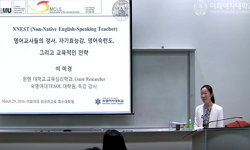Hochschild(1983)가 감정노동자들은 사회 계급과 구조 그리고 기업의 감정표현 규칙에 의해 감정이 관리되고 통제된다고 한 이래 지금까지 진행된 대부분의 감정노동 연구는 기업이 규정한 감정...
http://chineseinput.net/에서 pinyin(병음)방식으로 중국어를 변환할 수 있습니다.
변환된 중국어를 복사하여 사용하시면 됩니다.
- 中文 을 입력하시려면 zhongwen을 입력하시고 space를누르시면됩니다.
- 北京 을 입력하시려면 beijing을 입력하시고 space를 누르시면 됩니다.

감정노동자의 자기 효능감과 감정부조화의 관계에 미치는 귀인성향의 매개효과 = The Impact of Emotional Lavourer’s Self-Efficacy on Emotional Dissonance : Focused on the Mediation Effect of Attribution Disposition
한글로보기https://www.riss.kr/link?id=A102838127
- 저자
- 발행기관
- 학술지명
- 권호사항
-
발행연도
2017
-
작성언어
-
- 주제어
-
KDC
320
-
등재정보
KCI등재
-
자료형태
학술저널
- 발행기관 URL
-
수록면
273-304(32쪽)
- 제공처
-
0
상세조회 -
0
다운로드
부가정보
국문 초록 (Abstract)
Hochschild(1983)가 감정노동자들은 사회 계급과 구조 그리고 기업의 감정표현 규칙에 의해 감정이 관리되고 통제된다고 한 이래 지금까지 진행된 대부분의 감정노동 연구는 기업이 규정한 감정 표현규칙에 따라서 감정노동자들이 수동적으로 감정노동을 수행하는 것으로 전제하고 있다. 하지 만, 감정노동을 수행하는 것은 감정노동자 자신의 실제 감정과 상충될 수 있는 조건이나 상황을 야기하는 것이 되고 감정부조화와 그에 수반되는 여러 증상들은 이러한 감정노동의 수행 결과로 나타나는 일종의 심리적 갈등상태이므로 감정노동자는 자신의 심리적 안녕(psychological wellbeing) 을 유지・증진하는 데 도움이 되는 태도나 행동을 전략적으로 선택하려는 유인(incentives)을 갖게될 것으로 추론할 수 있다. 따라서 감정노동자들이 감정노동을 수행함에 있어 스스로의 자긍심과 자기 효능감을 높이거나 유지하기 위한 감정노동전략들을 구사할 것으로 보는 것이 타당하다.
본 연구의 목적은 감정노동에 대한 귀인과정이 감정노동자의 자기 효능감(self efficacy) 을 유지・고양하기 위해 전략적으로 이루어지는지와 감정노동에 따른 감정부조화 발생과정에서 개인특성 변인인 내・외통제 귀인성향이 매개변인의 역할을 하는지를 실증적으로 분석하는 것이다. 교육행정 서비스 노동자인 4년제 대학교에 근무하는 직원들을 대상으로 표본을 추출하여 이들의 자기 효능 감이 감정부조화에 미치는 영향을 살펴본 후에 자기 효능감이 감정부조화에 미치는 영향관계에서 귀인성향의 매개효과를 확인해보았다. 먼저, 자기효능감이 감정부조화에 미치는 영향을 살펴본 가설 1에 대한 통계분석 결과는 자기 효능감의 회귀계수의 부호가 부(-)의 방향으로 유의하게 나타 났다. 자기효능감이 감정부조화에 미치는 영향관계에서 귀인성향의 매개효과를 살펴본 가설 2에 대한 회귀분석 결과도 자기효능감과 감정부조화의 관계에서 귀인성향은 부분매개효과 있는 것으로 나타났다. 마지막으로, 자기 효능감과 감정 부조화의 관계를 매개하는 효과가 내・외통제 귀인성향에 따라 달리 나타날 것인지를 알아보기 위한 가설 3의 검증결과는 내통제 귀인성향의 매개효과가 뚜렷하고 분명한 것으로 나타났다.
본 연구는 교육행정 서비스 노동자들이 감정노동과정에서 스스로의 자기 효능감을 높이고 감정부조 화를 줄이려고 적절한 귀인전략(attribution strategy)을 구사하는 전략적 의사결정자임을 보여주고 있다.
다국어 초록 (Multilingual Abstract)
Since Hochschild (1983) argued that emotional laborers’ emotions are controlled and managed not by their individual voluntary will but by social class and structure as well as various external factors, most studies related to emotional labor have be...
Since Hochschild (1983) argued that emotional laborers’ emotions are controlled and managed not by their individual voluntary will but by social class and structure as well as various external factors, most studies related to emotional labor have been carried out on the premise that service labours passively conduct emotional labor in accordance with emotional display rules set by companies.
However, it is reasonable to think that emotional laborers seem to resort to an emotion labor strategy to enhance self esteem and self efficacy by themselves, when they conduct emotional labor. It seems that emotional laborers have incentives to adopt an attitude and behavior in a strategical way to maintain and improve their own psychological wellbeing.
The objective of this study is to find out whether the attribution of emotional dissonance is done strategically to maintain and enhance the self efficacy of emotional laborers, and to examine whether the internal and external control attribution disposition, an individual characteristics variable, functions as a mediating variable, in case of occurrence of emotional dissonance resulting from emotional labor, by selecting specimens from educational administrative service laborers who are working at four-year universities and analyzing them in an empirical way.
All in all, the results of this study showed that educational administrative service laborers are an strategic decision maker who employ an attribution strategy to enhance self efficacy while reducing emotional dissonance in emotional labor processes occurring at their work-places.
목차 (Table of Contents)
- I. 서 론
- Ⅱ. 이론적 배경
- Ⅲ. 연구 설계
- Ⅳ. 실증분석 결과
- Ⅴ. 결 론
- I. 서 론
- Ⅱ. 이론적 배경
- Ⅲ. 연구 설계
- Ⅳ. 실증분석 결과
- Ⅴ. 결 론
동일학술지(권/호) 다른 논문
-
단계적 적용 및 공인된 콘텐츠 가치평가가 크라우드펀딩에 미치는 효과
- 한국산업경영학회
- 이성희(Lee, Sunghee)
- 2017
- KCI등재
-
조직안전풍토와 안전의식이 직무만족・조직몰입에 미치는 영향 연구- 조직신뢰를 매개로 -
- 한국산업경영학회
- 이경재(Lee, Kyung-Jae)
- 2017
- KCI등재
-
- 한국산업경영학회
- 안홍복(An, HongBok)
- 2017
- KCI등재
-
- 한국산업경영학회
- 김문태(Kim, Moon-Tae)
- 2017
- KCI등재





 스콜라
스콜라



